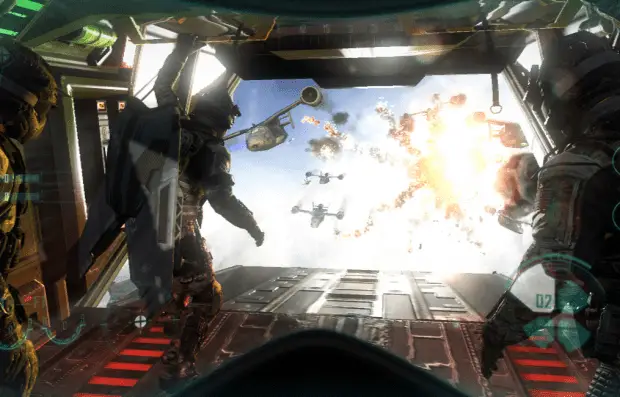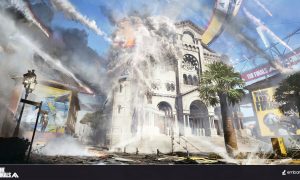
Another year, another Call of Duty game; Its been proven time and time again that the yearly release cycle can make or break a franchise, and COD has had a fairly good run so far. Based on sales and critical reception, it would be hard to characterize the series as anything other than a record-breaking juggernaut, but the gamer zeitgeist has shifted subtly, and the lens of time has led to a more critical assessment of the previous two installments in the series- Black Ops and Modern Warfare 3. It was clear that this year’s release- Black Ops II- would not be able to get by on name alone.
As the “second unit” on the Call of Duty series, Treyarch has become as synonymous with the brand as Infinity Ward ever was. As Activision’s go-to studio for backing up their higher-profile franchise makers, Treyarch’s work on the “off” years has steadfastly maintained the level of quality put forth by the series creators. As Infinity Ward brought the series into the Modern Warfare era, Treyarch continued the standard of the historical settings that Call of Duty was famous for with World at War. Flexing this newfound freedom, they released Black Ops two years later, historical context intact, but moving the narrative out of the now-tired World War II setting and into the Cold War era. With a multi-generational plot set primarily in the near future, Black Ops II represents a stronger break from tradition for Treyarch, and the result is both pleasantly refined and invigorating.
Author’s note: This review is partially based on time spent with the game on a debug kit at a review event held by Treyarch and Activision in Carlsbad, CA from October 23-25th. While most elements of the game are identical to it’s Xbox360 counterpart, it has been evaluated extensively on the PS3 for the purposes of this review.
Campaign
While striving for movie-like, summer blockbuster-style storytelling, Call of Duty has never been known for being particularly strong in terms of narrative. The constant switching of characters and factions from mission to mission, while a hallmark of the series dating back to the first few World War II era titles, has typically made each game seem more like a group of vignettes, lacking in cohesive storytelling. Not only does Black Ops II present a surprising strong and compelling narrative experience, it deftly balances the more on-rails portions of the campaign with some incredibly organic story branching. One of the highlights during and after my play through of the game was comparing notes with the other journalists at the event and discovering just how different my story played out compared to that of my colleagues. Some of these differences were very subtle with only small divergences, but others were massive in scope, resulting in dramatically different endings. Decision points are so expertly folded into the story and gameplay that it is difficult to say what specific actions led to the end game results I got.

Of course, branching storytelling only works if the core story is worth telling, and I’m happy to say that Black Ops II has what I consider to be the most compelling and personal single player campaign of the series to date. Some will draw similarities to the Metal Gear Solid series due to the milieu, and its clear there is more than a passing resemblance at times. The first act of the campaign is punctuated by several flashback sequences that put you in the shoes of the previous installment’s protagonist, Alex Mason (voiced once again by Sam Worthington), but for the most part you play his son. For the most part these sequences serve the narrative well, but there are a couple of moments that make no sense unless you’ve played Black Ops I. Referencing previous titles is fine, just make sure the newcomers don’t get confused as a result. The flashback sequences tell the backstory of the game’s antagonist, Raul Menendez, and his personal vendetta against the U.S. as well as Alex and David Mason. There’s something that reminds me of a Robert Rodriguez movie villain about Menendez, and as such he has a few very memorable over-the-top moments during the game.
[singlepic id=9889 w=320 h=240 float=left]A promising new element in the campaign is the Strike Force Missions. Presented as optional one-off levels that are unlocked as you progress through the main story, these missions bring in a more sandbox style of gameplay that may come off as a bit jarring on a first run. Instead of controlling a single character, you control a squad made up of infantry, drones and/or robotics defined by the mission parameters. Though you have the ability to take an overhead tactical approach, I found myself controlling individual units more often than not once I got the hang of things. The mission objectives and deployment combinations vary quite a bit, but I found them to be a bit uneven in difficulty, especially considering the order in which they are unlocked. Ultimately, I do feel they were fun to play and doing them definitely affected later levels in the game and the game’s ending, but I felt they could have connected better with the main story. An interesting idea that fell just a little short for me.
By setting the game in 2025, Treyarch effectively gave themselves license to stretch their imaginations a little more when it came to the weapons and environments that up until now had a firmer grip on reality. I actually loved the sprinkle of sci-fi that the setting introduced, from the jet-wing paratrooping to the Dubai-esque floating city. There’s just something really satisfying about launching a grenade from your wrist and firing sticky explosive charges from a flechette gun. There’s nothing that seems too far-fetched; everything looks and feels as if it could exist sooner rather than later. There is a strong emphasis on robotic warfare in Black Ops II (in fact, their use is central to the plot), however the variety of drones made available throughout the game never seem to do that great without direct supervision, especially in the Strike Force Missions.

Naturally, the PS3 version holds a slight edge on the graphical front, however the most striking thing visually about the game has little to do with the varied settings or weapon effects, but in the character models and animations. Many of the characters you interact with are familiar faces, from the actual appearances of Oliver North and Manuel Noriega, to supporting cast members bearing a resemblance to the actors playing them (such as Harper sounding AND looking like Michael Rooker). It really enhances the performance of the actors and contributes to the cinematic feel of the game. The voice acting in general is quite stellar, though there are times when Tony Todd’s General Briggs takes nonsensical pauses between lines, and for some reason the PS3 version had some odd lip-syncing issues during the first few levels. As for the score, Jack Wall’s soundtrack is suitably bombastic and militaristic in feel, while Trent Reznor’s theme for the game is a little edgier and more NIN-ish than recent motion picture projects he’s been a part of. Oh, and dubstep still popular on the dance floors thirteen years from now? I don’t think so.
Multiplayer
[singlepic id=9900 w=320 h=240 float=right]Black Ops II doesn’t stray too far from the tried and true, oft-copied multiplayer formula of the series, with new additions building onto an already solid core and incremental improvements that emphasize team play. Multi-Team (modes that allow up to three teams of three or four players) is so amazingly obvious it’s a wonder it hasn’t been widely implemented in shooter games before this. Of the three Multi-team modes (Team DM, Kill Confirmed, and Hardpoint), Hardpoint rose as a clear favorite, it basically being a King of the Hill type game with a ‘hill’ that constantly moves around the map over the course of a round. League Play attempts to level the playing field when it comes to skill, giving all players access to all customizable options (a feature also found in custom games) and matching them up based purely on skill. To further hammer home the team emphasis this year, “Kill Streaks” have been replaced with “Score Streaks”, giving players in-game rewards for more objective-based actions such as capturing territory or assists, in addition to racking up kills. Player customization has evolved into a “pick 10” system, with a maximum of ten slots available for custom loadouts, weapons, perks, attachments, and more. There is a ton of flexibility here, and it will be interesting to see what kind of combinations the diehard players come up with.
One of my biggest gripes with the Call of Duty games has been the barrier to entry for newer more inexperienced players. It can be a little daunting to try to learn the ropes of multiplayer when everybody around you has been playing and ranking their characters up as if their life depended on it. Black Ops II extends yet another olive branch to the “newbs” out there with a training mode that lets you test your loadouts and skills against bots. As an added bonus, you earn points up to a certain level (10 I believe), allowing you to step into the real deal with a little more experience under your belt.
Zombies
While multiplayer has always been like a game unto itself component of the Call of Duty franchise, bearing little or no connection to the campaign, at least it felt like the same game. Zombies feels like a totally different game, and in fact shares equal billing with Campaign and Multiplayer in the menu screens. I know Treyarch has been including this mode since World at War, but its hard to reconcile with the rest of the game, especially when you’re thrown into a level and key features aren’t even explained. For instance, there are parts that you can go around and collect to assemble something, but what? And why? The levels are fun wave-based survival sandboxes but overall feel like they belong to some other game. Given the incredible amount of other content on the disc, Zombies feels a little superfluous.
[singlepic id=9903 w=320 h=240 float=left]But wait, there’s more! Throw in the incredibly robust new CODcasting theater mode (that allows you to broadcast previously recorded games from just about any camera angle with an added audio track) and the awesome new video editing and sharing tools (that will likely be copied by dozens of games over the next few years) and you’ve got a ridiculous amount of value for your sixty bucks. In fact, those features are so extensive that we’re planning an in-depth article that explores them in greater detail.
With a single-player campaign that finally lives up to the hype of movie level quality and a solid multiplayer experience that clearly shows the benefits of a yearly iterative cycle, Call of Duty: Black Ops II comes close to being one of the best titles in the series. The uneven Strike Force Missions and incongruous Zombie mode distract from an otherwise stellar experience. Luckily, both modes of play are optional and don’t detract too much from the core game, and with the amount of content that Activision and Treyarch have packed on this disc, it shouldn’t even matter.

Mike Dunn is the old man of Gaming Trend, having cut his teeth on Atari consoles and First Edition Advanced Dungeons & Dragons back in the day. His involvement with Gaming Trend dates back to 2003, and he’s done everything from design and code to writing and managing. Now he has come full circle, with a rekindled passion for tabletop gaming and a recent debut as Dungeon Master (nearly forty years after he purchased the original DMG).

See below for our list of partners and affiliates:























